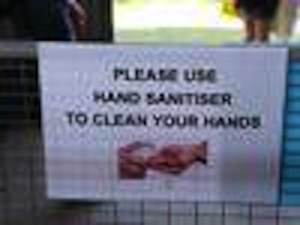Arinn Dixon Widmayer of Raleigh, North Carolina, writes in the Charlotte Observer:
As I sat in a darkened room in the middle of the night watching a nurse hook up a dialysis machine to my pale and shivering 7-year-old son, I wondered how in the world we ended up here.
It was October 2011, and my husband and I had been watching our son’s health all week. He stood motionless on the soccer field on Tuesday night, white  as a sheet, as the ball rolled by. By Thursday, he was nauseated and feverish. Our pediatrician told us to keep him hydrated, reduce the fever, that it was a bug and he’d get past it. By the weekend, he was eating little, sleeping most of the day.
as a sheet, as the ball rolled by. By Thursday, he was nauseated and feverish. Our pediatrician told us to keep him hydrated, reduce the fever, that it was a bug and he’d get past it. By the weekend, he was eating little, sleeping most of the day.
This is a tale any parent can tell. We see it all the time – children with a virus, a cold, the flu. Parents worry, give them medicine, juice and too much TV, and in a few days they perk up and get back to their normal selves.
Except when they don’t.
During that weekend, the pediatrician thought maybe our son had eaten something that made him sick. She treated his symptoms and started running some tests for infection. It was at that visit I first heard a suggestion of salmonella, of listeria, of E. coli.
By Monday, he was in bad shape. I helped him to the bathroom that morning and hugged him while he sat there crying that his tummy hurt. Once I got him standing back up, I turned to flush the toilet and froze. It was full of blood. Only blood. Within three hours, an ER doctor was explaining test results. It was E. coli.
I closed my eyes, just relieved to have a name for this suffering, so I wasn’t looking at the doctor’s face when she uttered the words “double kidney failure.”  And then I was in that dark room with the doctors and nurses and the dialysis machine. How did we get here?
And then I was in that dark room with the doctors and nurses and the dialysis machine. How did we get here?
Our son was infected with E. coli at the N.C. State Fair. Public health officials narrowed the site of his infection to the Kelley Building, one of the animal exhibit areas. It was a no-contact exhibit where the animals were fenced in. My family walked up and down the rows of pigs, sheep and goats. Our kids pointed and giggled at the jumping goats and fuzzy sheep. When we left the building, we stopped at the hand-washing station at the door and cleaned up. We did everything right. We avoided the petting zoo. We didn’t eat near the animals. We used the hand-washing stations when we left the exhibit and before we ate. None of us ever touched an animal. And our son still ended up enduring six dialysis treatments, four blood transfusions, 15 days in the hospital and a brush with death because of our decision to walk into that building.
Our son was just one of 27 people infected with E. coli at the State Fair in 2011. Add that to 108 people infected at the fair in 2004 and another three in 2006, and we end up with a serious public health issue. State health officials have recently made changes to the fair to reduce the risk of infection. They changed traffic patterns in the animal exhibits, increased the number of hand-washing stations, added signage warning fairgoers against touching animals and other measures.
Those are great steps toward protecting the public, but are they enough to protect fairgoers this year? I’m not advocating keeping animals and fairgoers separated by a glass wall, and I don’t pretend to know what else the fair can do to eliminate the risk of infection. But I do have to wonder whether large crowds and animals that carry deadly bacteria can coexist without the risk of E. coli? And at what point do those risks outweigh the benefits?
Handwashing is never enough. While some studies suggest inadequate handwashing facilities may have contributed to enteric disease outbreaks or washing hands was protective against illness, others suggest relevant infectious  agents may be aerosolized and inhaled. Handwashing tool selection may also contribute to the success of hand hygiene as a preventive measure, as some outbreak investigations have reported alcohol-based hand sanitizer was not protective against illness, especially when hands are soiled.
agents may be aerosolized and inhaled. Handwashing tool selection may also contribute to the success of hand hygiene as a preventive measure, as some outbreak investigations have reported alcohol-based hand sanitizer was not protective against illness, especially when hands are soiled.
All the refs can be found in our 2012 paper, a sorta secret petting zoo shopper, Observation of public health risk behaviors, risk communication and hand hygiene at Kansas and Missouri petting zoos – 2010-2011.
I’m fine with animal interactions; but people, and organizers, should be a lot more careful than they thought. That’s what I told my 3-year-old’s daycare as they prepared for a chicken coop. I’m not sure people like that message.
Further, sanitizers have limited effectiveness, and in a petting zoo situation, so does handwashing; it’s only one component of an overall strategy to reduce risk. But it’s easy to say handwashing because that blames the patrons, not something else.
A table of petting zoo outbreaks is available at http://bites.ksu.edu/petting-zoos-outbreaks.
Erdozain G, Kukanich K, Chapman B, Powell D. 2012. Observation of public health risk behaviours, risk communication and hand hygiene at Kansas and Missouri petting zoos – 2010-2011. Zoonoses Public Health. 2012 Jul 30. doi: 10.1111/j.1863-2378.2012.01531.x. [Epub ahead of print]
Abstract below:
Observation of public health risk behaviors, risk communication and hand hygiene at Kansas and Missouri petting zoos – 2010-2011Outbreaks of human illness have been linked to visiting settings with animal contact throughout developed countries. This paper details an observational study of hand hygiene tool availability and recommendations; frequency of risky behavior; and, handwashing attempts by visitors in Kansas (9) and Missouri (4), U.S., petting zoos. Handwashing signs and hand hygiene stations were available at the exit of animal-contact areas in 10/13 and 8/13 petting zoos respectively. Risky behaviors were observed being performed at all petting zoos by at least one visitor. Frequently observed behaviors were: children (10/13 petting zoos) and adults (9/13 petting zoos) touching hands to face within animal-contact areas; animals licking children’s and adults’ hands (7/13 and 4/13 petting zoos, respectively); and children and adults drinking within animal-contact areas (5/13 petting zoos each). Of 574 visitors observed for hand hygiene when exiting animal-contact areas, 37% (n=214) of individuals attempted some type of hand hygiene, with male adults, female adults, and children attempting at similar rates (32%, 40%, and 37% respectively). Visitors were 4.8x more likely to wash their hands when a staff member was present within or at the exit to the animal-contact area (136/231, 59%) than when no staff member was present (78/343, 23%; p<0.001, OR=4.863, 95% C.I.=3.380-6.998). Visitors at zoos with a fence as a partial barrier to human-animal contact were 2.3x more likely to wash their hands (188/460, 40.9%) than visitors allowed to enter the animals’ yard for contact (26/114, 22.8%; p<0.001, OR= 2.339, 95% CI= 1.454-3.763). Inconsistencies existed in tool availability, signage, and supervision of animal-contact. Risk communication was poor, with few petting zoos outlining risks associated with animal-contact, or providing recommendations for precautions to be taken to reduce these risks.










